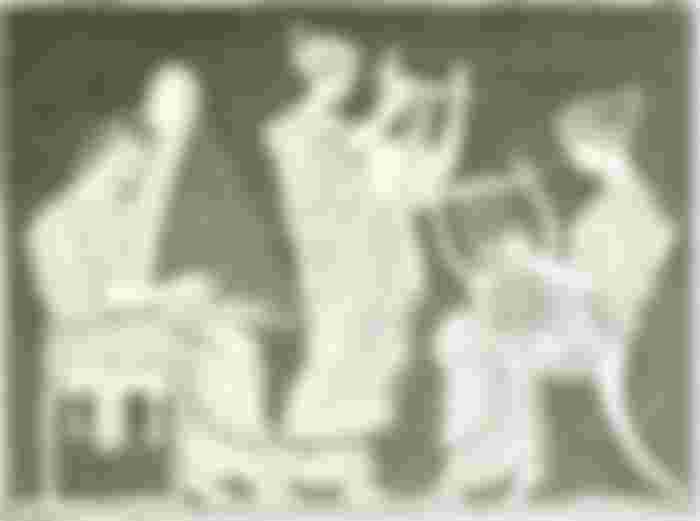Modal Moods: Dorian Mode

Back in the 1950s the British musicologist Deryck Cooke wrote a book about musical expression and communication, in which he presented many fascinating details about how music functions as a universal language. Music is a communicator of feelings, whether or not words are included. I don’t know if other writers have already discussed the application of the principles expounded in his book, The Language of Music, as applied to modally-conceived music, so the following is a result of my own meditations on the topic.
Music students and musicians with a grounding in music fundamentals and who can grasp basic principles of musical harmony will be familiar with the topic presented and developed in this essay. Personal acquaintance with how accompanying music functions to create a “mood” in a dramatic movie scene, video game, or live stage performance also helps. A knowledge of scale construction, intervals, and chord progressions, provides a starting point for understanding my development of these points.
Cooke’s theory describes how, by musically emphasizing certain notes and patterns in a passage of tonal music, specific feelings can be generated in the heart or mind of the listener. He does not, however, establish a set of “rules” or “prescriptions” on how to write music, but presents evidence illustrating how these principles manifest themselves in different lands and times. Since every culture’s unique musical heritage grows up from its roots – is “cultured” in its own unique soil – none is inherently “superior” or “inferior” to another. In a sense, national or “ethnic” music is like food, cooked and seasoned, and served in a particular way, but most anyone can eat and derive nourishment from it! For example, morning coffee brewed in South Sudan (with added ginger) wakes me up at least as well as coffee served in the Caribbean, or in New York City, though the flavors are not identical! So, musical examples illustrating the theoretical concepts in this essay could be drawn from literature, songs and drama of many cultures, past and contemporary. Perhaps I will do just that in another article. But for now, let’s consider the topic at hand.
THE MODES
Let’s review and expand on what was earlier presented about the old musical modes. There are six basic modes, each possessing its own unique character, sitting on a continuum that runs from musically “bright” to “dark.” For the sake of clarity in this series, we will use the following ancient Greek terminology to designate these six modes: Lydian, Ionian, Mixolydian, Dorian, Aeolian, and Phrygian.
The seventh mode, called Locrian, is mainly theoretical, rarely used in actual music, but we may refer to it from time to time, for purposes of comparison and contrast with the six practical modes.
For simplicity here, we restrict our focus to the key signatures having zero sharps and flats, which are comparable to the familiar C major and A minor keys. Therefore, the finals (root notes, or tonics) of the seven modes with no sharps or flats are, respectively:
F Lydian, C Ionian, G Mixolydian, D Dorian, A Aeolian, E Phrygian, and B Locrian modes.
We should always associate the alphabet names of the notes with the solfège system, so that all of the ancient modes can be transposed to any other key signature and staff. Transposition is easily accomplished by moving the solfège syllables to the corresponding notes of each tonality and key signature.
FA Lydian, DO Ionian, SOL Mixolydian, RE Dorian, LA Aeolian, MI Phrygian, and TI Locrian modes.
D (RE) DORIAN MODE
Moving forward: With all the above in mind, we will stay with Dorian mode for the remainder of this essay. Dorian is a good place to start, because on the light-dark continuum, Dorian sits in the exact center of the mode list. The solfège syllables for the Dorian mode, in order from lowest to highest tones, are always as follows: RE MI FA SOL LA TI DO RE’. Descending: RE' DO TI LA SOL FA MI RE.
Correspondingly, the unaltered or natural notes of the D Dorian mode are, in order from lowest to highest, D E F G A B C D’, and descending, D C B A G F E D. To taste the musical “flavor” of this D Dorian mode, the reader is advised to practice playing and hearing the notes on a piano keyboard or other musical instrument. It’s also good to sing the indicated solfège tones, up and down the mode.
Supplementary: There are additional “rules” and techniques for systematically altering the tones of Dorian and the other modes, such as raising or lowering one or more of the notes by a chromatic semitone – called musica ficta - but we shall merely mention the musica ficta technique in this essay, without going into detail. How we incorporate such fancy embellishments of the musical line can be cleared up at another time, but first we have to master the modal basics!
All modal scales consist of consecutive tones that are either a semitone or a whole tone apart. When there are no flats or sharps, the natural semitones occur between MI-FA, and TI-DO. Take a look at the natural (white) keys of this piano keyboard, these two pairs of notes are E/F, and B/C. Notice that there are no sharp or black keys between these pairs of notes, whereas all the other adjacent tones in the scale are arranged in whole tone pairs: RE-MI, FA-SOL, SOL-LA, and LA-TI, and DO-RE’. Or, D-E, F-G, G-A, A-B, and C-D’; note that there is a sharp, or black key, separating the notes of each of those latter pairs.

(FYI the apostrophe on the D’ or RE’ simply means the note of the same name, but one octave higher than D and RE.)
So in the Dorian mode the half-step pairs are always the second and third tones, and the sixth and seventh tones. Applying this formula to D Dorian, we see that the half-steps are again between E and F, and between B and C. The reader’s mental awareness of the position of these half-step pairs – E/F and B/C, or MI/FA and TI/DO – is important while considering Deryck Cooke’s ‘basic tonal components of expression’, as discussed in The Language of Music.
In addition, measuring the distance up from the tonic or “final” of the mode is equally important. When we count the tones ascending from the root, or tonic note, the vertical intervals of Dorian mode are as follows: Perfect Unison (Tonic), Major Second, Minor Third, Perfect Fourth (Subdominant), Perfect Fifth (Dominant), Major Sixth, Minor Seventh, and of course, the Perfect Octave. In abbreviated nomenclature, we will call these P1, M2, m3, P4, P5, M6, m7, and P8, with the “P” meaning “Perfect,” upper case “M” indicating the “Major,” and lower case “m” designating the “Minor” intervals. Most music students are already aware of this terminology.
How does all the above translate to D Dorian mode? The notes of the eight intervals listed in the previous paragraph and ascending melodically, are D-D, D-E, D-F, D-G, D-A, D-B, D-C’, and D-D’. To hear and relate each tone to the tonic note, the reader should practice playing all these note pairs on a piano keyboard. Even better, sing the second tone of each pair while repeating and sustaining the “D” note sound on the piano!
MUSICAL EXPRESSIVENESS OF D DORIAN MODE
The Cooke book (!) goes on to describe the musical expressiveness of each of these tones sitting at basic (diatonic) intervals above a tonic note, in the usual tonal system. However, now we will extract and apply some of his descriptions to the notes of D Dorian mode. The following is our application of these descriptions to the modal scale that includes the consecutive diatonic notes running from D to its octave D’, Dorian mode. The reader is also advised to try out the ‘sing or play’ instructions:
Perfect Unison & Octave (D Tonic): Emotionally neutral; context of finality, “the end” of a song-piece section or entire song-piece: A common example is when somebody sings out “Ta Dah!” and takes a mock final bow, usually in a humorous context. They sing the Tonic note, twice. In this mode, Sing or Play D D, then RE RE. The reader should try doing this now!
Major 2nd, D-E, RE-MI: Emotionally neutral as a passing tone between D and F (RE and FA, 1 and 3). As a whole-tone tension down to the tonic – E down to D, MI down to RE – this Major second (M2) above the tonic is heard in a context of finality, signifying the ending of a song section or song-piece. Sing or Play D E D, RE MI RE, D E F, RE MI FA, then F E D, FA MI RE, D E D, RE MI RE.
Minor 3rd,D-F, RE-FA: Concord, but since the minor third (m3) is a lowering or ‘depression’ of the more natural Major third (M3), the m3 always seems to express a “stoic” acceptance, tragedy (Cooke’s description). Sing or Play D F, RE FA, then F D, FA RE.
Perfect 4th, D-G, RE-SOL: As a passing note, the perfect 4th (P4), a G note, between F and A, bridging FA and LA, seems emotionally neutral. Sing or Play D G D, also F G A A G F D, then RE SOL RE, also FA SOL LA LA SOL FA RE.
Perfect 5th (the Dominant, at a P5), D-A, RE-LA: Also emotionally neutral, now in a context of flux, intermediacy. Sing or Play D A D, then RE LA RE.
Major 6th (M6), D-B, RE to TI: Emotionally neutral as a passing tone bridging A and C (LA and TI). As a whole-tone tension pulling down to the dominant (B down to A, TI to LA). This recalls the major (Ionian) context, a pleasurable longing in a context of flux. Sing or Play D B D, then RE TI RE, also D B A, then RE TI LA.
Minor 7th, D-C’, RE-DO’: Semi-tonal tension down to the Major 6th (C’ down to B; DO’ down to TI). Feels unsatisfactory, wants to continue resolving down yet another step to the dominant; this is a tone that feels “lost,” emotion of mournfulness. Sing or Play D C’ B D C’ B A, then RE DO’ TI RE DO’ TI LA.
Now that was a lot of information to digest. And there remain at least five more modes that we have not even discussed! Rather than going further with application to all the modes in this already long essay, however, readers are encouraged to first experiment with hearing, singing (solfège), or playing these various tones and intervals on a piano keyboard, to get them fully nested in the inner ear. There will be differences in the emotional affect when applying these principles and techniques to the other five or six modes, because the actual tones of each mode are slightly altered. So we can refer to these in future installments.
Finally, here are a few other factors to bear in mind: Dynamics (volume, the continuum of loud and soft musical sounds), time (relative duration of individual tones), and direction (whether tones are moving up or down, in relation to each other) will either emphasize or dampen the expressive impact of each of the tones at the specified distances from the tonic, whether M2, m3, P4, and so forth. In addition, the tone coloring (which musical instrument or singing voice is used to perform the music) as well as the Texture (such as monophonic, homophonic, polyphonic) also play roles in characterization of a tune, further influencing the expressive impact of everything we’ve presented above.
SUMMARY
So what ground have we covered so far? Most music is rooted in and grows out of the soil of its time and culture, but the principles of musical communication are similar, as expounded on by musicologist Deryck Cooke in his classic text, The Language of Music. The ancient Greek modes can be used as examples to illustrate the application of these principles, as each mode is based on specific intervallic relationships, the distances between the tones making up the mode.
This essay zeroed in on the Dorian mode in D, to illustrate some concepts. There are slight variations when these principles are applied to the other modes, when utilizing the results of Cooke’s research, but it is best to confront these details in a later installment (and is less tedious for the patient reader!).
IMAGE CREDITS: All images of ancient Greek instruments shown in this essay were free and in the Public Domain (searchable and downloadable from Flickr.com and the Internet Archive site). Commercial use is permitted.




The music then was so beautiful, but now some musicians are trying their best to bring back to life the real music, some are just out there to make money and be popular that's all the care, but the truth is if any artist at all uses all this then his music will be very beautiful and lovable